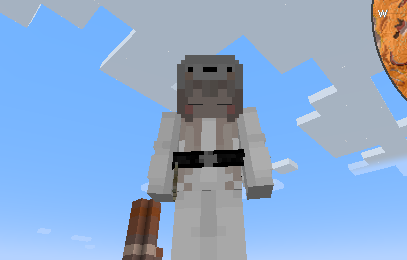Adding Trinkets by KubeJS
Since adding renderer to trinket is surely something not easy, I think some introduction here would be good.
Installing ProbeJS is recommended, so you can get those methods and fields more easily.
Here I will make a Botania-like sash item step by step, with only the render code.
Before actually doing the render, getting things like models/textures to render is important. There are 12 arguments passed in 1 call of render, which is clearly too much for any function to handle well.
So they're all wrapped up as Context, which is demonstrated below:
onEvent("item.registry", event => {
event.create("void_sash", "curios:trinket")
.render(context => {
let {
stack, //The itemstack of the trinket
entity, //The entity trinket is about to be rendered on
poseStack, //The "space" for trinket to render
bipedModel, //The model of the entity
buffers, //Where you tell GPU to do all sorts of thing.
ageInTicks, //How many ticks have passed
light, //The surrounding light level for rendering
partialTicks, //A more fine-grained tick for rendering
netHeadYaw, //Your nose turn left or right
headPitch, //Your nose turn up or down
limbSwing, //Limb swing thing
limbSwingAmount, //How much your limb swings
} = context;
})
})For most of the time, we only need some of them to render things well - fields can be omitted if you don't need them. All the arguments we needed in this tutorial are as follows:
onEvent("item.registry", event => {
event.create("void_sash", "curios:trinket")
.render(context => {
let {
poseStack, //The "space" for trinket to render
bipedModel, //The model of the entity
buffers, //Where you tell GPU to do all sorts of thing.
light, //The surrounding light level for rendering
} = context;
})
})By default, everything will be rendered at a same position, with a fixed scale. In order to render things as you need
them to be, you will need to make some changes to the poseStack, like scaling them up or down, or translating them by
a certain offset.
Luckily, the belt rendering is attached to the body - so we don't need to translate the poseStack, but only upscale
them by a bit to fit player model:
poseStack.scale(1.15, 1.15, 1.15)You can try to translate the stack by calling so things will be moved by x, y, z for a more straightforward
demonstration of how poseStack affects the rendering:
poseStack.translate(x, y, z)...Or rotating is fine, too:
//The Vector3f java class is needed here to get the axis,
//this is allowed in class filter by KubeJS Curios
let Vector3f = java("com.mojang.math.Vector3f");
poseStack.mulPose(Vector3f.XP.rotationDegrees(180))There are some useful methods provided in Curios and Trinkets too, you can check them out by using CuriosRenderer
and TrinketRenderer in code (And completions would pop up if you have ProbeJS installed). Or read their source code
on their GitHub repos.
Even though we don't need such thing in the render code since we are doing something quite static and fixed, testing them out can be useful for you to understand the rendering.
Finally, we will have our code like:
onEvent("item.registry", event => {
event.create("void_sash", "curios:trinket")
.render(context => {
let {
poseStack, //The "space" for trinket to render
bipedModel, //The model of the entity
buffers, //Where you tell GPU to do all sorts of thing.
light, //The surrounding light level for rendering
} = context;
poseStack.scale(1.15, 1.15, 1.15)
})
})We are rendering belt, which is attached to the player body model - so we don't need to create our own models, just need to stitch textures to them! So we can do like to get texture into the buffer:
const beltTexture = new ResourceLocation("kubejs:textures/model/void_sash.png")
let buffer = buffers.getType(bipedModel.renderType(beltTexture))This line feeds the texture location to the model we're rendering to get the RenderType, and then pass it to
the buffers.getType to get the loaded model texture.
You can check out the void_sash.png at here. Note the similarity
between it and other armor model textures, since we're rendering it on a player model, their textures would be similar.
Our code looks like this now:
onEvent("item.registry", event => {
//Put the constants outside so your code would be more clear.
const beltTexture = new ResourceLocation("kubejs:textures/model/void_sash.png")
event.create("void_sash", "curios:trinket")
.render(context => {
let {
poseStack, //The "space" for trinket to render
bipedModel, //The model of the entity
buffers, //Where you tell GPU to do all sorts of thing.
light, //The surrounding light level for rendering
} = context;
poseStack.scale(1.15, 1.15, 1.15)
let buffer = buffers.getType(bipedModel.renderType(beltTexture))
})
})And so we have the textures loaded, the last step is to actually render them:
const NO_OVERLAY = (0 | 10 << 16)
bipedModel.body.render(poseStack, buffer, light, NO_OVERLAY, 1, 1, 1, 1)Here we render the belt by passing our transformed poseStack, the buffer containing our model texture, the light
level in rendering, and a bunch of other parameters. We stitched the model to body by calling render
of bipedModel.body, so the rendering of the belt would go with how player's body move - no matter you're swimming,
running or sneaking or doing other kinds of moves.
There are other ways of rendering, too, like render the item stack directly:
Client.getMinecraft().getItemRenderer()
.renderStatic(
stack, "none",
light, NO_OVERLAY,
poseStack, buffers, 0
)Where the stack is the item stack, or any other item stack you created. The none here tells Minecraft that how you
want to transform the item model - like as in hand, on an Item Frame or others.
Back to the topic, we should have our final code looking like:
onEvent("item.registry", event => {
//Put the constants outside so your code would be more clear.
const beltTexture = new ResourceLocation("kubejs:textures/model/void_sash.png")
const NO_OVERLAY = (0 | 10 << 16)
event.create("void_sash", "curios:trinket")
.render(context => {
let {
poseStack, //The "space" for trinket to render
bipedModel, //The model of the entity
buffers, //Where you tell GPU to do all sorts of thing.
light, //The surrounding light level for rendering
} = context;
poseStack.scale(1.15, 1.15, 1.15)
let buffer = buffers.getType(bipedModel.renderType(beltTexture))
bipedModel.body.render(poseStack, buffer, light, NO_OVERLAY, 1, 1, 1, 1)
})
})With everything in place (including the model texture in assets folder), you should look like:
